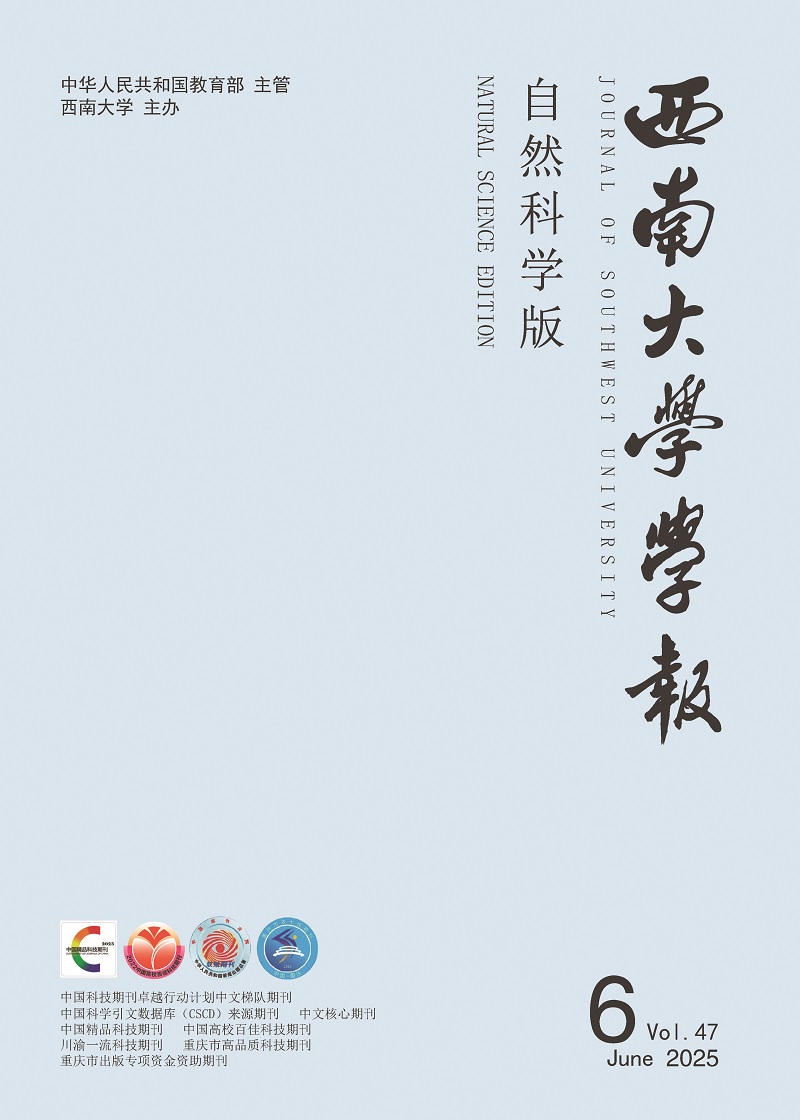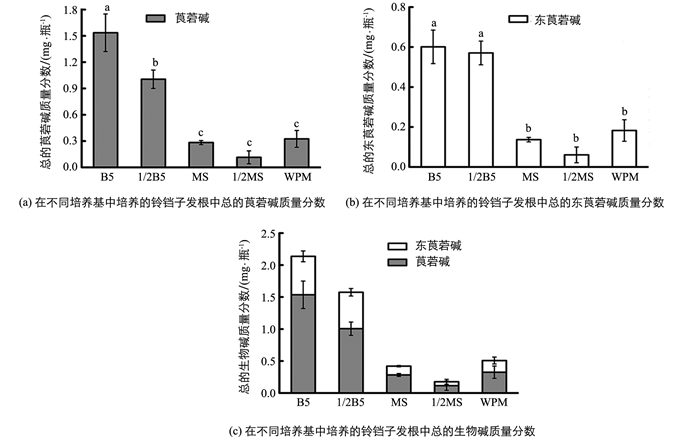-
铃铛子(Anisodus luridus)为茄科多年生宿根草本植物,藏语名为“唐冲那薄”,主要分布在西藏等海拔在2 500~4 000 m的山坡草地、林缘及田地宅旁.铃铛子根和种子可供药用,有抗痉挛和止痛作用,医药上常用其根提取莨菪碱类生物碱[1].
托品烷生物碱(tropane alkaloids,TAs)是一类来自茄科植物的生物碱,是副交感神经系统的有效抑制剂,主要药用成分为莨菪碱和东莨菪碱[2].由于托品烷生物碱的化学合成成本较高,目前其供应仍然依赖于从植物中提取.托品烷生物碱在野生茄科植物中质量分数很低,故而寻求新途径来提高托品烷生物碱的产量尤为重要.铃铛子作为托品烷生物碱的药源植物之一,其野生资源正在逐渐枯竭.目前发根培养成为研究药用植物次生代谢产物的有效手段,而关于铃铛子发根培养条件的优化尚未有报道.本研究建立了铃铛子发根的转化体系,并对最适于铃铛子发根生长和生物碱积累的培养基进行优化筛选,为获得托品烷生物碱提供了新的途径,具有重要的理论意义和应用价值.
HTML
-
铃铛子种子由西藏农牧学院兰小中教授鉴定并提供.
-
农杆菌C58C1 (pRiA4) 由西南大学天然产物与代谢工程实验室保存.
1.1. 植物
1.2. 菌株
-
分别剪取约1 cm见方的叶片,1.5 cm长的茎段,0.5 cm长的子叶放入已活化好的菌液中,振荡浸泡约10 min后,用无菌滤纸吸干多余菌液.将叶片、茎段和子叶分别平铺在MS(含100 μmol/L的乙酰丁香酮)固体培养基上,于25±1.0 ℃恒温暗培养48 h后转入含抗生素400 mg/L头孢噻肟钠的MS固体培养基上除菌培养,待发根生长到2 cm左右时剪下,转移到新的含400 mg/L头孢噻肟钠的MS固体培养基中培养,每20 d继代1次,直至除菌完全.
-
取200 mg除菌彻底的发根应用CTAB法[3]提取基因组DNA,同时提取铃铛子无菌苗的根DNA作为阴性对照.另取200 μL活化的农杆菌C58C1菌液,12 000 r/min离心2 min,去上清,20 μL ddH2O悬浮,沸水煮5 min,12 000 r/min离心2 min,上清作为阳性模板.所用rolB基因和rolC基因引物参照Zhang等[4].
-
选取长势较好、分支较多的真叶上诱导出的发根T3株系,作为铃铛子发根生长研究的实验对象.为找出铃铛子发根生长的最适培养基,本文选取了7种不同培养基作为测试培养基:N6,1/2B5,B5,WPM,MS,1/2MS和White,蔗糖作为碳源,质量浓度为30 g/L.将各培养基pH调至5.8,分装于250 mL的广口三角瓶中,每瓶100 mL,121℃灭菌20 min.每瓶发根的接种量为10根2 cm左右的发根,鲜质量大约为100 mg,每种培养基3瓶重复,于110 r/min,25℃摇床暗培养.
-
托品烷生物碱的提取及HPLC分析参照Wang等[2]的方法.
2.1. 铃铛子发根的获得
2.2. 发根rolB基因和rolC基因的PCR检测
2.3. 发根生长最优培养基的筛选
2.4. 托品烷生物碱的提取和高效液相色谱HPLC分析
-
本实验用农杆菌C58C1侵染铃铛子不同的外植体,在25d后统计生根外植体的个数,真叶中出根外植体的个数是16个,诱导率达到了53.33%,茎段中出根外植体的个数是18个,诱导率达到了60.00%(表 1).
外植体的类型不同,农杆菌侵染后的反应也不同(图 1).真叶上生出的发根较粗壮,分支较多,根毛更发达,长势较快,而且单片真叶上诱导出发根数量比茎段多,但诱导率与茎段相比要略低.茎段的诱导率最高.茎段上长出的发根与真叶上诱导出的发根相比不够粗壮,分支较少.子叶不能诱导出发根,原因是子叶分化程度比真叶低,维管束发育不完善.综上所述,铃铛子真叶是农杆菌诱导发根的最佳外植体.
-
植物细胞产生发根是由于Ri质粒上携带有致发根相关的rol基因,Ri质粒通过转化进入植物细胞并将rol基因整合进入植物核基因组,从而使得植物细胞获得发根这种新的遗传属性,rolB和rolC基因是最为常用的鉴定发根真实性的基因[5]. PCR结果证明培养的铃铛子发根是真正的转化发根.
-
对不同培养基之间的生物量进行分析(表 2),结果显示:发根在B5培养基中生长最快,鲜质量和干质量都达到最大值,1/2B5培养基中发根鲜质量和干质量也较大. B5和1/2B5培养基与WPM,MS,1/2MS培养基相比,含有较低浓度的NH4+,低浓度的NH4+有利于铃铛子发根的生长. N6,White培养基中发根几乎不生长,N6,White成分简单,微量元素不仅种类少而且质量分数也很低,抑制了发根的生长.综上所述B5培养基是最适合铃铛子发根生长的培养基.
-
发根T3株系在7个培养基中培养后,用HPLC测定莨菪碱和东莨菪碱的质量分数(表 3).在N6和White培养基中发根的生物量较少,全部研磨后混合称质量和测定,仍然检测不到莨菪碱和东莨菪碱的存在.在B5液体培养基中铃铛子发根的莨菪碱质量分数最高,达到了3.49±0.13 mg/g,其次是1/2B5,1/2MS,MS和WPM.而对于东莨菪碱,1/2B5液体培养基中培养的发根中质量分数最高,达到了1.43±0.22 mg/g,其次是B5,MS,1/2MS和WPM.从表 3中可见在B5液体培养基中培养的发根的东莨菪碱质量分数与1/2B5液体培养基的相比差异无统计学意义.
仅根据生物碱质量分数并不能确定最终收获的生物碱的总量,根据东莨菪碱(莨菪碱)产量为发根的干质量总量与发根中东莨菪碱(莨菪碱)质量分数的乘积,可计算出每种培养基发根中东莨菪碱(莨菪碱)的产量(图 3).
从图 3可见,在B5液体培养基中培养的发根中莨菪碱和东莨菪碱的产量要高于其他种类的培养基.综合发根生物量和生物碱产量两个方面分析,B5液体培养基中培养得到的铃铛子发根,莨菪碱和东莨菪碱总量都是最高的,分别达到了1.5±0.21 mg/瓶和0.6±0.08 mg/瓶.根据总生物碱产量为总的莨菪碱产量与总的东莨菪碱产量之和,可统计出铃铛子发根在不同培养基中的总生物碱产量,在B5培养基中总的生物碱产量达到了最高,为2.1±0.29 mg/瓶,其次是1/2B5,WPM,MS和1/2MS.
3.1. 不同类型外植体对诱导频率的影响
3.2. PCR进行铃铛子发根阳性株系的鉴定
3.3. 发根生长最优培养基的筛选
3.4. 铃铛子发根中东莨菪碱和莨菪碱的HPLC质量分数测定
-
农杆菌种类、被感染部位细胞类型以及生理状况等因素的不同,使T-DNA插入植物基因组的位置、长度和拷贝数千差万别[5].本实验分别选取了真叶、茎段和子叶作为外植体,其受到农杆菌C58C1 (pRiA4) 侵染后的反应有很大的差异,子叶对于侵染完全没有反应,茎段上诱导出的发根生长状态较弱,从而选取无菌苗的真叶作为最佳的外植体.
各种培养基由于所含的成分和比例不同,因此对发根的生物量、生长状态和次生代谢产物的形成有不同的影响[6-10].将真叶上诱导的发根转接到N6,1/2B5,B5,WPM,MS,1/2MS和White 7种不同的液体培养基中,以B5液体培养基中培养的发根生物量积累速度最快,莨菪碱碱质量分数最高,总生物碱产量最高,最适宜培养铃铛子发根.这是由于B5液体培养基中含有较低浓度的铵态氮和较高浓度的硝态氮,而培养基中铵态氮和硝态氮之间的比例会影响发根生长和次生代谢产物的合成[11],硝态氮比例高,铵态氮的浓度低,有利于铃铛子发根生物量的积累和生物碱的合成,具体的原因还需要进一步研究.
本实验成功建立了铃铛子发根诱导和培养体系,同时对铃铛子发根的培养条件及其次生代谢产物累积进行了初步研究.结果表明铃铛子无菌苗的真叶为农杆菌诱导发根的最佳外植体,铃铛子发根在B5液体培养基培养时生物量积累最多,托品烷生物碱合成最多,对进一步规模化生产莨菪碱和东莨菪碱奠定了基础.









 DownLoad:
DownLoad: